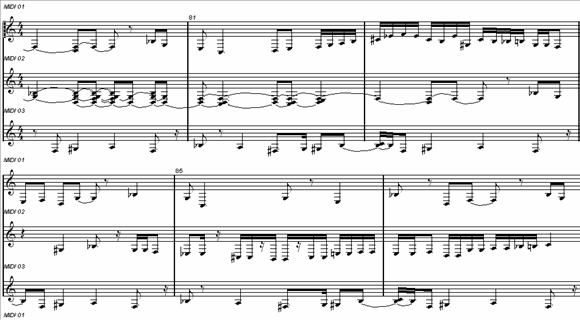View current page
...more recent posts

"Subharmonic Duo" (Piano) [mp3 removed]
Kind of a slow baroque modernist blues composition for piano, using the same notes as "Subharmonic Duo" minus the beats. The score above is an except near the end. (The title has been changed.)
"Dyspeptic Bass" [mp3 removed]
I spent the holidays working on songs and finally sat down with the manual and learned to use a hardware sequencer. I originally had the idea I would write all my material in the computer but someone on a chatboard I look at described the Electribe R-1 mkii as a "sketchbook" for rhythmic ideas and that idea appealed. (I got one a while back--they're pretty cheap--but had mainly been using it as a tone generator and a source of MIDI to mangle.) Of course the sketches can be recorded as audio or MIDI and developed further in the computer. The song above uses one of my first "drawings"--I kept the rhythm simple and put most of my energy into a kind of extended slow motion prog solo played on a different instrument, a software synth. [/music diary]
Update: this is the same basic melody as "Subharmonic Duo" but I called it "Dyspeptic Bass" because the synthesizer sounds gastronomically challenged. Maybe it's time for a Pink Floyd parody called "Gastronomy Domine."
In the comments to the previous post where I was complaining about the emphasis on timbre (musical sound or texture) in a recent New York Times story, p.d. reminds me that changes in timbre are the creative engine behind, like, all my favorite music (techno, hiphop, and so forth). He tells a great story about "Berry Gordy making the engineers build a radio transmitter and everyone heading out into the car to check how the motown test masters sounded...and remix, re-eq, recut, and test, etc...for the whole day because he knew if it didn't sound 'right' on the radio it wouldn't sell." p.d. points out how many current hiphop hits have built on such sonic refinements, from Motown right up through '90s drum and bass experiments, turning them into main attraction.
All true, but I don't think the sound scientist I was hectoring, Daniel Levitin, was talking about artists who consciously base their music on equalization or synth textures, a la the Detroit techno guys. He means monster hits, which I maintain rely as much on the marketing of personality and yes, old fashioned musical hooks. A good case in point was Cher's "Believe," to which the Times devoted an anatomy-of-a-chart-topper story several years ago. It was quite funny: Cher came off as the grumpy CEO of her corporate musical enterprise, complaining at development meetings to the teams that had various parts of the song parceled out to them. Seems they had the verses in the pipeline for six years but the chorus was eluding them (or maybe the reverse). She admonished one team to "go out and get more pain in their lives" to develop an effective hook. Someone had some weak lines and tried them with the vocoder and the rest is musical history. So, yes, timbre put the song over the top but the hit also resulted from nuts and bolts Tin Pan Alley songwriting. The acoustic scientist Levitin has discovered an interesting fact about current music but is announcing it as a principle. And no offense to anyone in a lab about the dig in the last post--my point is mainly that art is its own kind of rocket science but journalists love to dumb it down by reducing it to something quantifiable.
